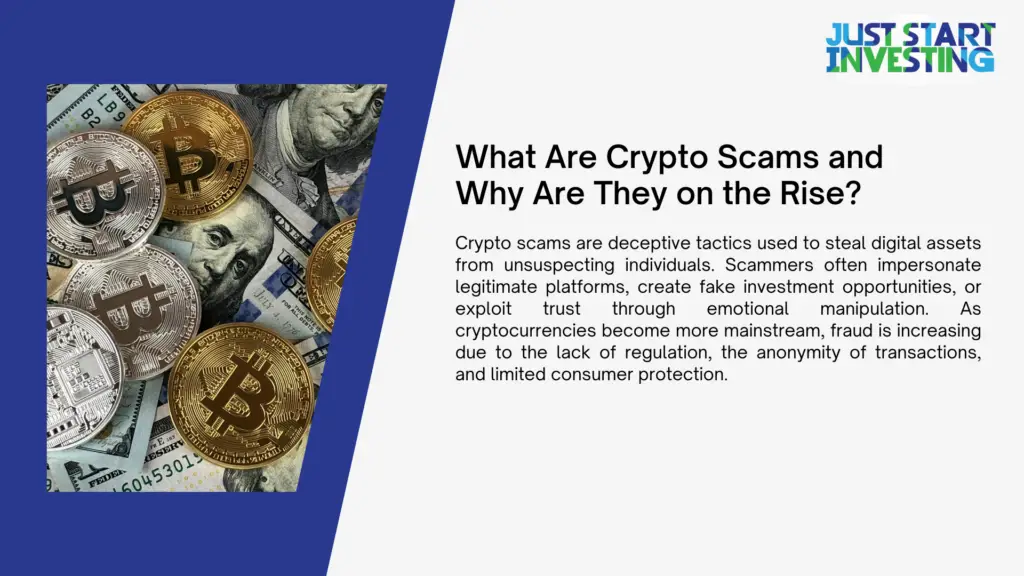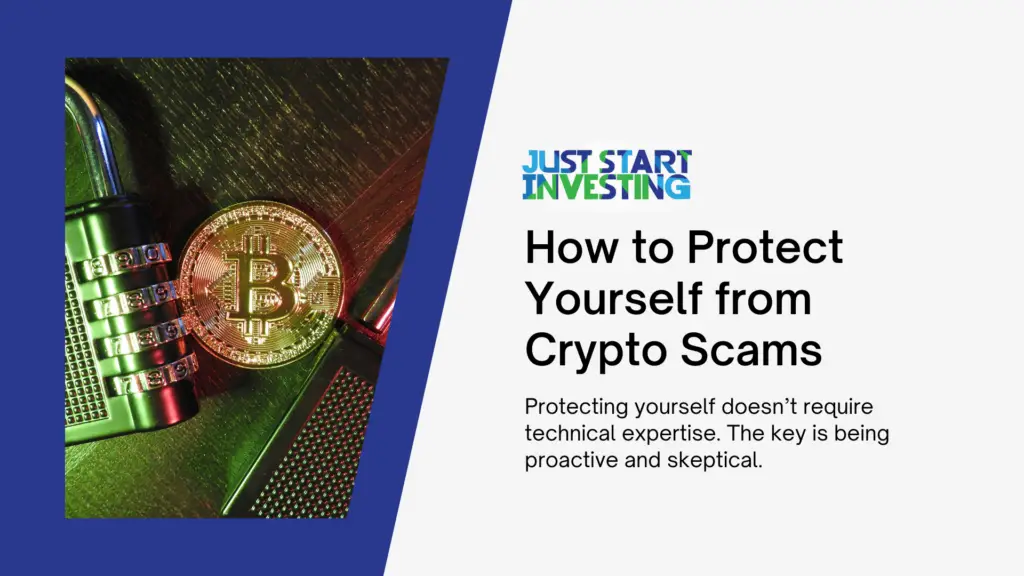Every day, people lose thousands of dollars to crypto scams that seem trustworthy at first glance. These frauds are made to appear authentic, communicate in your language, and deceive you before you even recognize it. Whether you’re investing in a new coin, using a trading platform, or simply browsing social media, scammers are always one step ahead unless you know what to watch for.
In this article, you’ll learn the key warning signs of a crypto scam, the different forms they can take, and what you should do before sending your crypto anywhere. Being prepared can mean the difference between staying safe and losing your entire investment.
What Are Crypto Scams and Why Are They on the Rise?

Crypto scams are deceptive tactics used to steal digital assets from unsuspecting individuals. Scammers often impersonate legitimate platforms, create fake investment opportunities, or exploit trust through emotional manipulation. As cryptocurrencies become more mainstream, fraud is increasing due to the lack of regulation, the anonymity of transactions, and limited consumer protection.
How Do Crypto Scams Work?
At the core of most crypto scams is social engineering. This technique uses psychological manipulation to trick people into giving away their personal information, wallet access, or funds. Here’s how scammers typically operate:
- Phishing and Impersonation: Scammers create fake websites or send emails that look identical to legitimate crypto platforms. They ask for login credentials or private keys to gain control of your wallet.
- Fake Investment Opportunities: These scams promise guaranteed profits or incredibly high returns. Once you send your crypto, the platform vanishes or blocks your account.
- Pump-and-Dump Groups: These groups inflate a coin’s value by spreading hype online. Once enough people invest, the group sells off their holdings, leaving others with worthless coins.
Crypto transactions are irreversible, and most wallets do not require identity verification. This makes it extremely difficult to trace stolen funds, which is why cryptocurrency is often favored by scammers.
Is Crypto Real Money?
Yes, it is. Cryptocurrencies hold real financial value and can be exchanged for fiat money like U.S. dollars, euros, or pounds. Scammers exploit the misconception that crypto is “just digital code” by convincing users they are not losing anything substantial. However, once your funds are transferred, there is rarely a way to retrieve them.
Scammers also prefer crypto because it is borderless and difficult to trace. Traditional bank accounts have fraud protection and identity verification. Crypto accounts do not. As a result, criminals find digital currencies to be more convenient for illegal activity.
A Complete List of the Most Common Crypto Scams
Scammers constantly adapt to new platforms, trends, and user behavior. Below is a breakdown of the most common and dangerous types of crypto scams.
Investment Scams
These scams usually involve fake websites, slick marketing videos, and guarantees of high profits.
- Ponzi Schemes: These pay older investors with money from new victims. The system collapses when new funds stop coming in.
- Fake Trading Platforms: These mimic real exchanges but exist solely to steal deposits.
- Forex Crypto Scams: These scams combine the volatility of foreign exchange with crypto hype to create fake trading accounts.
Romance and Emotional Manipulation Scams
These scams begin with a personal relationship and end in financial loss.
- Scammers build relationships online and then introduce a fake crypto opportunity.
- Victims are persuaded to “invest” or send money to help with emergencies.
This type of scam is often called “pig butchering” because the scammer spends weeks or months fattening up the victim emotionally before making a financial move.
Phishing and Impersonation Scams
These take place on email, social media, and messaging apps.
- Crypto Email Scams: Victims receive fake alerts asking them to verify account details.
- WhatsApp and Instagram Scams: Hacked or fake accounts message people with investment tips or urgent requests for help.
- Twitter Crypto Scams: These often involve impersonated celebrity accounts offering fake giveaways or asking users to send crypto for rewards.
Bot and Automation Scams
- Fraudulent services claim to use automated trading bots to make consistent profits.
- Fake performance dashboards are created to show “successful” returns.
- Victims are encouraged to deposit more after seeing early wins, which are often simulated.
Social Engineering & Identity Theft
- Fake Celebrity Endorsements: Scammers use doctored images, fake interviews, or deepfakes to promote fraudulent projects.
- Giveaway Scams: Users are told to send a small amount of crypto to receive more in return.
- Fake Job Offers: Scammers post fake remote crypto job listings that ask for personal information or upfront training fees.
How to Spot a Crypto Scam Before It’s Too Late
Not all scams are obvious. Many look legitimate at first glance and are professionally designed to trick even cautious investors.
Red Flags to Watch Out For
- Unrealistic Returns: Any platform that promises to double your investment or offer fixed profits is highly suspect.
- High-Pressure Tactics: Scammers often create false urgency, insisting you act now or miss out on an opportunity.
Lack of Transparency: Scammers rarely provide clear contact details, verifiable company information, or real team members.
Questions to Ask Before You Invest
Before you deposit crypto anywhere, ask these questions:
- Who is behind this platform or project, and are they publicly verifiable?
- Is the company registered, licensed, or audited by a third party?
- Are there legitimate reviews from credible sources?
- Is communication professional, or are there red flags such as typos and inconsistencies?
Examples of the Biggest Crypto Scams in History
Looking at past scams can help you spot the patterns. Here are some of the most infamous examples:
- BitConnect: Marketed as a crypto lending platform, it turned out to be a $3.5 billion Ponzi scheme.
- OneCoin: Claimed to be a Bitcoin rival but was completely fake. The founder disappeared, and thousands of investors lost everything.
- PlusToken: Based in Asia, this scam promised high returns and defrauded users of over $2 billion.
How to Protect Yourself from Crypto Scams

Protecting yourself doesn’t require technical expertise. The key is being proactive and skeptical.
Security Tips for Investors
- Use a hardware wallet to store your crypto offline.
- Enable two-factor authentication (2FA) on all crypto platforms.
- Never share your private keys or seed phrases with anyone.
Safe Practices on Social Media and Messaging Platforms
- Avoid clicking on links from people you do not know.
- Do not trust unsolicited messages claiming you won a giveaway or need to act urgently.
- Check usernames carefully to avoid fake or impersonated accounts.
Using Verified Tools and Platforms
- Stick with exchanges and wallets that are well-established and regulated.
- Avoid platforms promoted through direct messages, YouTube comments, or Telegram groups.
- Be cautious of projects that lack independent reviews or third-party verification.
What to Do If You’ve Been Scammed
Realizing you’ve fallen for a crypto scam can be stressful and overwhelming. While it may feel like there’s nothing you can do, there are important steps you can take to respond quickly, report the crime, and reduce the chances of further loss.
Is It Worth Reporting a Scammer?
Yes. Reporting helps law enforcement track down scammers and prevent future fraud. Even if your funds are not recovered, your report adds to a growing database of criminal activity.
Where to Report Crypto Scams
- Federal Trade Commission (FTC): reportfraud.ftc.gov
- Internet Crime Complaint Center (IC3): ic3.gov
- Your country’s cybercrime division: For example, Action Fraud in the UK or Europol in Europe.
How to Get Your Money Back from Crypto Scams
- Contact your wallet or exchange provider as soon as possible.
- Use blockchain analysis tools or recovery specialists to track stolen funds (with caution, as some recovery services are scams themselves).
- If you use a debit or credit card to buy crypto through a platform, you may be eligible for a chargeback.
Final Thoughts: Staying Safe in the Crypto World
As the cryptocurrency space continues to evolve, so do the threats that come with it. As technology fosters creativity and financial independence, it also gives con artists new avenues for operation. Staying safe means being informed, cautious, and proactive.
The Future of Crypto and Regulation
The future of crypto will likely include tighter regulations, particularly around exchanges, token offerings, and user verification. Governments and regulatory bodies across the world are slowly catching up, aiming to introduce rules that balance innovation with consumer protection. Stricter laws can deter scammers, improve accountability, and help victims take legal action when fraud occurs.
Even with more oversight, education remains the most powerful tool in preventing scams. When users understand how scams operate, recognize red flags, and know how to verify information, they are far less likely to fall victim. Understanding more about wallets, blockchain, and cryptocurrency developments can make you more capable of navigating this area securely.
Summary Checklist: How to Prevent Crypto Scams
Use this quick checklist as a reminder every time you engage in a crypto-related activity:
- Verify before investing: Always research the company, team, and platform before sending any money. Look for registration details, third-party reviews, and verifiable contact information.
- Avoid unsolicited messages: Be skeptical of direct messages on social media or messaging apps that involve crypto tips, job offers, or giveaways. If you didn’t ask for it, don’t trust it.
- Educate yourself constantly: Crypto is a fast-moving industry. Take time to learn about wallet security, blockchain mechanics, and emerging scam tactics. The more informed you are, the safer your investments will be.

Just Start Investing is a personal finance website that makes investing easy. Learn the simple strategies to start investing today, as well as ways to optimize your credit cards, banking, and budget. Just Start Investing has been featured on Business Insider, Forbes, and US News & World Report, among other major publications for its easy-to-follow writing.
